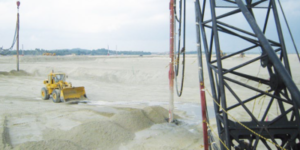 Considering the economic, environmental and structural benefits of ground improvement, it is a bit surprising that more deep foundation projects haven’t leveraged these techniques more often. Some of that may be due to a simple lack of understanding about what ground improvement actually means and the difference it can make for projects in less-than-ideal soil conditions.
Considering the economic, environmental and structural benefits of ground improvement, it is a bit surprising that more deep foundation projects haven’t leveraged these techniques more often. Some of that may be due to a simple lack of understanding about what ground improvement actually means and the difference it can make for projects in less-than-ideal soil conditions.
In this article, we’ll provide a quick overview of why ground improvement is important and, in particular, what the advantages are to utilizing vibratory stone columns or vibro-compaction methods.
Why ground improvement matters.
While there may be no such thing as a perfect site, many projects can get off on the wrong foot quite literally because of soil conditions. By soil conditions, we’re talking about the soil’s bearing capacity — the ground’s ability to support the loads applied to it by whatever structure is being built on or in it. We see this come into play in sites where clay, silt, sand or gravel soil don’t meet the requirements of bearing capacity, lateral stability and other factors.
Ground improvement methods are a vital step in ensuring foundation longevity, which makes choosing the right approach that much more important. However, stone columns and vibro-compaction represent easier, more advanced approaches that are highly productive and lower cost than using steel or concrete.
Stone columns are an ideal application for a wide variety of ground conditions, from clay to silt to sand. The advantages here are that stone column applications can be implemented quickly, allowing for more ground improvement in less time. In addition, stone columns are more environmentally sound than other materials typically used in deep foundations, such as concrete or steel. Last, by utilizing stone instead of wet concrete, the project site production does not rely on inbound concrete delivery. Stone can be stored on-site for use as needed, keeping production running smoothly without interruption.
Stone column soil treatments also increase vertical drainage and embankment stability. Notably, stone columns are a good choice for areas with seismic activity, helping reduce the risk of soil liquefaction.
Vibro-compaction offers advantages for sand and gravel applications. Just like it sounds, this approach uses vibrations to cause surrounding soil to rearrange into a more densely packed state. We see this approach used effectively in reclaimed land from the sea, lakes and dredging operations, as well as offshore projects. In this method, a lance penetrates the soil down to the desired depth. As sustained vibrations from the lance begin compacting the soil, the lance works its way upward from the bottom. The compacted soil forms a cylinder around the lance, lowering the surface level of the soil around the lance. The gap can then be backfilled with material from the site. This method is perfect for contaminated sites where removal of spoils can be problematic and costly.
Again, the benefits here are many. The process simply increases the density of the soil that is already on site, adding nothing damaging to the environment. Extension tubes can be added to the lance to work at almost any depth. Plus, the technique offers the same reduced risk of soil liquefaction in areas prone to seismic activity.
The bottom line.
Ultimately, it’s about choosing the right ground improvement approach for the job. It has to be right for the type of soil and conditions. It has to be effective at creating the right base on which the project can be built. And it has to be cost-effective and efficient in order to keep the project on track. Vibratory stone column and vibro-compaction are two methods that check all of the boxes.
Talk with us to learn more about which ground improvement approach is right for your next job. At IDE, we have the expertise, equipment and support to help you improve soil conditions and get your project on solid ground.

Recent Comments